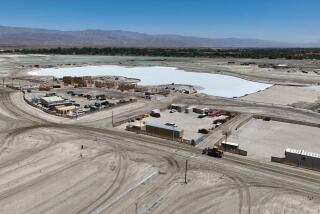Lindsay Lohan movie ‘The Canyons’ finds allure in architecture
Though it features adult-film star James Deen and some explicit sex scenes, the only porn in “The Canyons” -- the new movie directed by Paul Schrader and written by Bret Easton Ellis -- is architecture porn.
For design buffs, “The Canyons” will likely be a big turn-on, though not always in conventional ways. The movie, starring Lindsay Lohan and Deen as a young, amoral Hollywood couple, places its principle action in a stunning modernist house that is located, appropriately enough, in a Malibu canyon.
“The Canyons” also spotlights a different kind of architecture -- the ugly, impersonal design of multiplex cinemas. The decrepit facades and interiors of these abandoned cineplexes form the visual chapter markers of a movie that is, in many ways, about the death of traditional moviegoing.
PHOTOS: Scenes and stars from ‘The Canyons’
Schrader said that the Malibu property at the center of the movie functions as one of the story’s main characters. The director and his crew spent a week shooting in and around the house in the summer of 2012. (The micro-budgeted movie, partially financed through Kickstarter, was shot in just three weeks.)
“It’s a house without a bad angle,” said Schrader, speaking by phone recently. The dramatic staircases, both indoors and outdoors, were particularly photogenic. “Once you get in the house, you are just seduced by those stairs. I shot them in four different ways and none of them are the same.”
Located in Malibu’s Carbon Canyon, with a panoramic view of the Pacific Ocean, the house is jaw-dropping as much for its structure as for its location. The main structure, which features large swooping curves that unite its disparate geometric shapes, is the private residence of its architect and designer, Vitus Mataré, who has worked on several properties in the area.
PHOTOS: Arts and culture in pictures by The Times
In a recent tour, Mataré (who is a grand nephew of the noted German artist Ewald Mataré) explained that the house was in poor shape for many years due to fires and a landslide that literally broke the property in half. He acquired it in 2006, with a group of investors, and later became the sole owner, overhauling and restoring it to its present condition.
The house features an open-plan interior that “doesn’t allow for much privacy,” said Mataré. For the movie, the lack of privacy serves as a visual corollary to the constant digital spying and surveillance perpetrated by the characters on each other. As Deen’s trust-fund brat/movie producer Christian warns the Lohan character, “No one has a private life anymore, Tara.”
Mataré allowed Schrader to use the house for free. (The movie was originally going to be set in a Venice beach house.) He also let Schrader shoot original artwork hanging on the walls. The movie’s much-discussed four-way sex scene takes place under a work by Ed Ruscha -- a 1982 lithograph titled “People Yawning.”
FULL COVERAGE: 2013 Spring arts preview
Another Ruscha work -- a 1969 piece from his Standard series -- can be seen on the wall of the living room, as can a photograph by Richard Misrach. (The presence of fine art echoes Schrader’s “American Gigolo,” in which the Richard Gere character hangs a David Hockney painting in his apartment. Schrader said he now owns the Hockney.)
“The Canyons” joins a list of L.A.-set movies that use modern architecture as the domicile of a wealthy sleazebag with shady motives. In movies as varied as Brian De Palma’s “Body Double,” Curtis Hanson’s “L.A. Confidential” and Steven Soderbergh’s “The Limey,” modernist houses serve as the architectural locus of sin and depravity.
“There are some huge challenges that filmmakers face in using architecture,” said Ted Braun, a professor at USC’s School of Cinematic Arts. “The best angle of the house may not be the best angle for the actor or the story. To find a building that is responsive to cinematic action, the team really has to have a common vision.”
As Schrader put it, “we just got lucky.” The movie used existing buildings and “we didn’t have to pay to use them.”
[Updated:] Producer Braxton Pope said that the movie used architect Richard Neutra’s Strathmore Apartments in Westwood for the home of characters played by Nolan Funk and Amanda Brooks. The complex has been designated an official L.A. Historic-Cultural Monument.
The montages of decrepit movie houses seen throughout “The Canyons” represent a kind of architecture anti-porn -- an immersion in the death and decay of moviegoing.
According to Schrader, Ellis’ original screenplay called for images of abandoned cinemas to bookend the various chapters of the movie. Schrader saw them as a way to signal to viewers that his decision to forgo traditional movie distribution channels was a deliberate one.
The decaying multiplexes may be aesthetically hideous, but they project a tragic grandeur that draws in viewers. As with its damaged characters, “The Canyons” finds something poetic and moving in these contemporary architectural ruins.
ALSO:
Pacific Standard Time’s architecture focus moves forward
Is Roger Ebert correct to dismiss modern architecture as ‘totalitarian’?
Critic’s Notebook: Woody Allen, Terrence Malick engage in architectural nostalgia
MORE
PHOTOS: Hollywood stars on stage
CHEAT SHEET: Spring Arts Preview
PHOTOS: Arts and culture in pictures
More to Read
The biggest entertainment stories
Get our big stories about Hollywood, film, television, music, arts, culture and more right in your inbox as soon as they publish.
You may occasionally receive promotional content from the Los Angeles Times.











